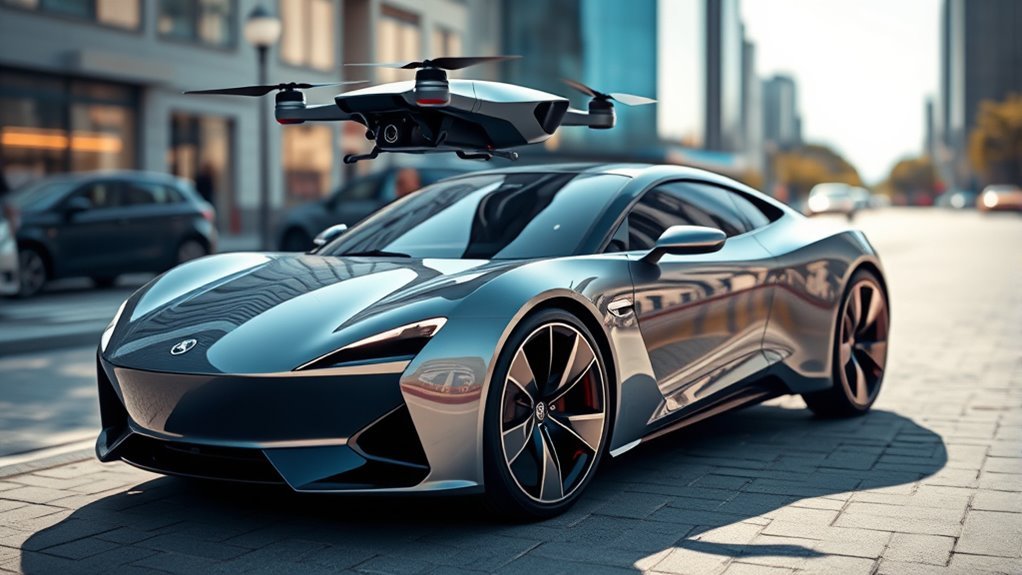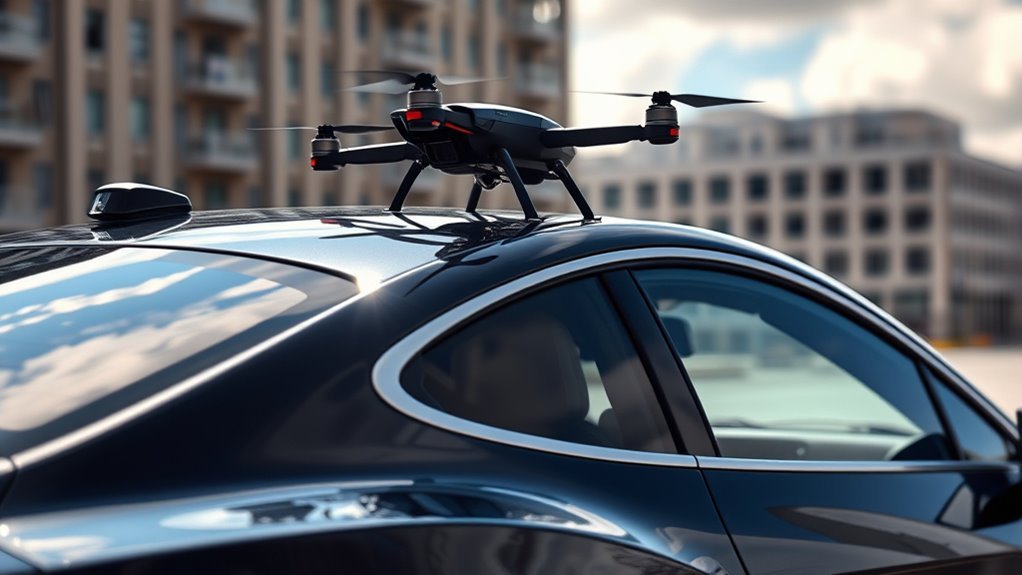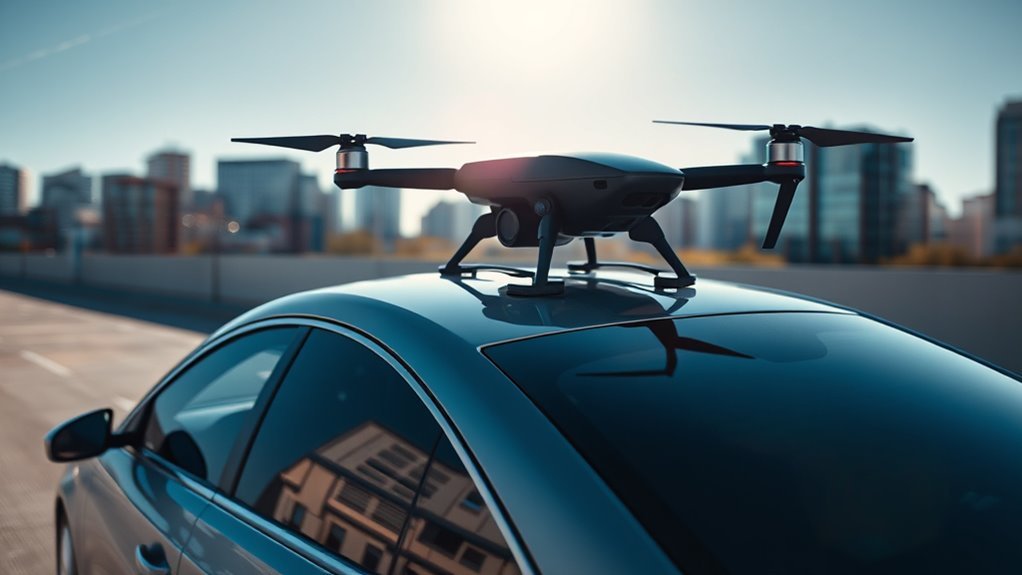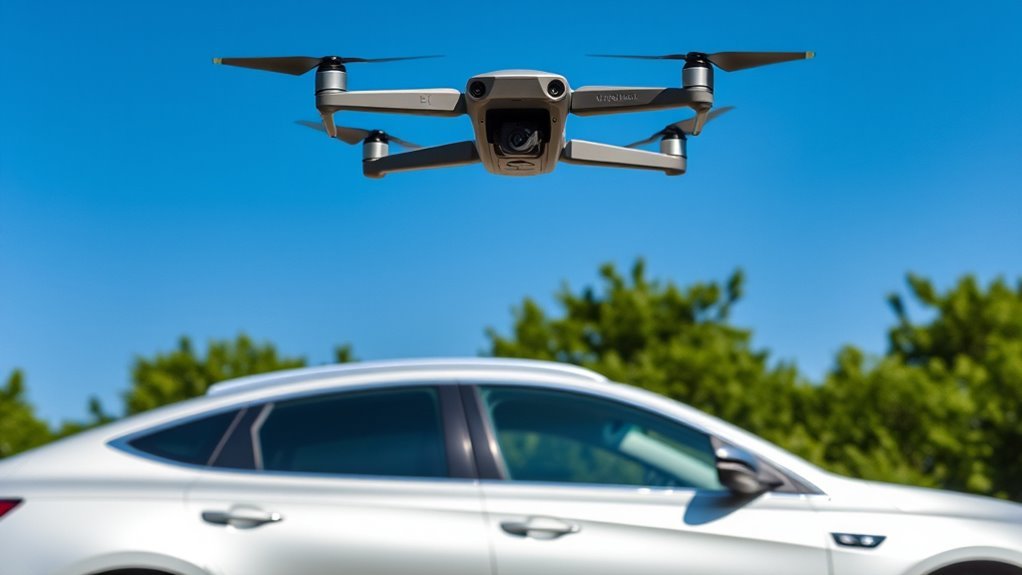A drone in a car is an advanced tool that enhances your driving experience by providing real-time data on navigation, safety, and maintenance. These drones utilize sensors and cameras to monitor surroundings and help traffic management. They also promote efficient route planning and assist in detecting potential vehicle issues. By integrating AI, drones redefine your interaction with vehicles, creating smarter and safer roads. There’s much more to explore about their impact and future potential.
Understanding Drones: From Military to Automotive

While drones are often associated with military applications, their evolution has greatly broadened their use, including integration into the automotive industry. You might be surprised to learn how these advanced devices have shifted from surveillance and combat roles to enhancing consumer vehicles. Drones can now aid in navigation, monitor surroundings, and even assist with traffic management, providing drivers with a unique perspective. This consumer usage improves safety and efficiency while promoting a sense of freedom on the road. As automotive technology continues to evolve, the incorporation of drones promises to redefine how you interact with your vehicle, transforming everyday driving into a more connected and informed experience. Embracing this innovation means revealing new potential in personal mobility. Furthermore, the integration of advanced AI enables drones to process real-time information, optimizing their functionality in automotive applications. This integration of drones with AI-driven choreography innovations allows for enhanced navigation and coordination in complex traffic scenarios.
The Technology Behind Automotive Drones

The technology behind automotive drones represents a fascinating fusion of advanced engineering and innovative design. These drones utilize cutting-edge drone technology, seamlessly integrated into vehicles to enhance functionality and expand capabilities. By employing lightweight materials and efficient power systems, automotive drones can achieve impressive flight times and maneuverability.
Sensors and cameras onboard provide real-time data, allowing you to capture stunning aerial imagery or conduct surveys with ease. The automotive integration of these drones means they can be deployed quickly, providing you with a sense of freedom and exploration. Additionally, advanced software and algorithms guarantee safe navigation, enabling you to focus on your journey while the drone handles the sky. Embracing this technology opens up exciting possibilities for both personal and professional use.
Types of Drones Used in Cars

When it comes to drones in cars, there are primarily two types you’ll encounter: aerial drones and surveillance/mapping drones. Aerial drones provide a bird’s-eye view for various applications, while surveillance and mapping drones are tailored for specific tasks like monitoring environments or creating detailed maps. Understanding these types can help you appreciate how they enhance automotive technology and functionality.
Aerial Drones Overview
Drones have revolutionized various industries, and their integration into cars is no exception. Aerial drones can enhance your driving experience, offering unique capabilities like capturing stunning aerial photography and enabling real-time data collection. Here are some types of aerial drones you might encounter in vehicles:
- Camera Drones: Ideal for high-resolution aerial photography, perfect for capturing scenic views.
- Surveying Drones: Used for land surveying and mapping, providing critical data for construction and agriculture.
- Delivery Drones: Designed for transporting goods, they adhere to specific drone regulations, ensuring safety and compliance.
Understanding these types of drones can empower you, allowing you to leverage their features while traversing the skies with freedom and responsibility.
Surveillance and Mapping Drones
Surveillance and mapping drones play an essential role in enhancing the functionality of cars equipped with this technology. These drones provide advanced surveillance applications, allowing you to monitor areas in real-time and gather critical data. With high-resolution cameras and sensors, they guarantee mapping accuracy, enabling precise navigation and planning. Whether you’re surveying land, inspecting infrastructure, or enhancing safety features, these drones offer unparalleled insights. By integrating with your vehicle’s systems, they deliver seamless connectivity and user-friendly controls, giving you the freedom to explore and analyze your surroundings. As technology advances, the potential for surveillance and mapping drones in cars will only expand, providing you with even greater capabilities for adventure and security on the road.
How Drones Enhance Safety Features
While you might think of drones primarily as tools for aerial photography or delivery, their integration into automotive safety features is revolutionizing the way we approach road safety. Drones enhance safety enhancements through advanced collision avoidance systems, providing real-time data that can detect potential hazards before they become critical.
- Real-time monitoring: Drones can assess surrounding environments, alerting you to obstacles.
- Enhanced visibility: They offer a bird’s-eye perspective, improving situational awareness on the road.
- Predictive analytics: By analyzing traffic patterns, drones help anticipate and mitigate accidents.
Incorporating these technologies into vehicles not only boosts your confidence while driving but also greatly reduces the risk of accidents, giving you more freedom on the road.
Drones for Navigation and Traffic Management
Drones can greatly enhance navigation and traffic management by providing real-time traffic updates and optimizing your route. With their ability to monitor conditions from above, these aerial devices help you avoid congestion and make informed decisions on the go. As a result, your driving experience becomes not only smoother but more efficient.
Enhanced Route Optimization
As traffic congestion continues to challenge urban mobility, innovative solutions like drones are emerging to enhance route optimization. By integrating drones into navigation systems, you can experience improved route efficiency and better traffic forecasting.
- Drones can analyze real-time traffic patterns, allowing for more accurate predictions.
- They provide alternative routes that minimize delays, keeping your journey smooth.
- By sharing data with vehicles, drones help drivers make informed decisions.
This combination of aerial insights and ground-level data transforms the way you navigate urban environments, enabling you to avoid bottlenecks and arrive at your destination faster. Embracing drone technology not only empowers you with freedom on the road but also contributes to a more efficient traffic ecosystem.
Real-Time Traffic Updates
When you’re maneuvering through bustling streets, having access to real-time traffic updates can make all the difference in your journey. Drones equipped with advanced sensors and imaging technology gather vital data, providing immediate insights into traffic conditions. This real-time analysis allows you to avoid congested routes, saving both time and fuel. By communicating directly with your car’s navigation system, drones can suggest alternative paths based on current traffic flow, accidents, or road closures. Imagine cruising freely while your vehicle adapts to changing conditions, keeping you in the flow. With these innovative tools at your disposal, you regain the freedom to travel efficiently, transforming the way you navigate urban landscapes. Embrace the future of driving with drones enhancing your journey.
The Role of Drones in Vehicle Maintenance
While you might think of drones primarily as tools for aerial photography or delivery services, their integration into vehicle maintenance is revolutionizing the industry. Drones enhance maintenance efficiency through precise drone inspections, allowing for quick assessments of hard-to-reach areas. This technology not only saves time but also reduces costs associated with traditional maintenance methods.
Drones are transforming vehicle maintenance with efficient inspections and cost-saving solutions for hard-to-reach areas.
- Rapid Damage Detection: Drones can quickly identify issues like leaks or structural damage.
- Data Analysis: They gather detailed data to inform more effective repair strategies.
- Safety Enhancement: Drones minimize the need for personnel in hazardous locations.
Future Innovations in Automotive Drones
Although the automotive industry has already begun to embrace drones for various applications, the future promises even more groundbreaking innovations that could transform how we think about vehicle technology. Imagine a world where your car autonomously deploys drones for delivery while you’re on the road, ensuring packages reach their destination faster and more efficiently. These drones could also enhance your driving experience by capturing aerial photography, providing real-time data about traffic conditions, or scouting scenic routes. With advancements in AI and connectivity, the integration between cars and drones will not only revolutionize logistics but also empower you with unparalleled freedom and convenience, making every journey more enjoyable and productive. The possibilities are endless, and you’ll want to be ready for what’s next!
Potential Challenges and Limitations of Drones in Cars
As the integration of drones into vehicles opens up exciting possibilities, it’s vital to contemplate the potential challenges and limitations that may arise. You might face various issues that could hinder the full realization of this technology, including:
- Privacy concerns: Drones capturing data could lead to unwanted surveillance, raising ethical questions.
- Regulatory hurdles: Maneuvering through existing laws and regulations can be complicated, slowing down deployment.
- Technological limitations: Current drone capabilities may not meet safety and reliability standards required for automotive use.
These integration challenges can impact the practicality and acceptance of drones in cars, making it essential to address them proactively. With careful consideration, you can help shape a future where drones enhance your driving experience without compromising your freedom or safety.
Frequently Asked Questions
Are Drones in Cars Legal to Use Everywhere?
Daring drone devotees, you’ve got to navigate nuanced drone regulations. While some states embrace aerial autonomy, others impose legal implications. Always check local laws before taking to the skies to guarantee you’re compliant and carefree.
How Much Do Automotive Drones Typically Cost?
When considering drone pricing, costs can vary considerably. Factors like technology, features, and brand influence the price. You’ll find basic models starting around a few hundred dollars, while advanced options can exceed several thousand.
Can Drones in Cars Operate in Bad Weather?
When you think about drone performance, weather challenges often come to mind. While drones in cars can handle some conditions, heavy rain or strong winds can greatly affect their functionality and reliability. Always consider the forecast!
How Do Drones Communicate With the Vehicle?
Drones communicate with the vehicle through advanced drone technology, utilizing wireless signals and sensors for seamless vehicle integration. This enables real-time data exchange, enhancing navigation and situational awareness, giving you greater freedom on the road.
What Industries Use Drones in Automotive Applications?
You’ll find drones enhancing automotive safety through real-time monitoring, while also revolutionizing delivery logistics by efficiently transporting parts and products. Their integration is reshaping industries, providing innovative solutions that empower your journey in the automotive world.

